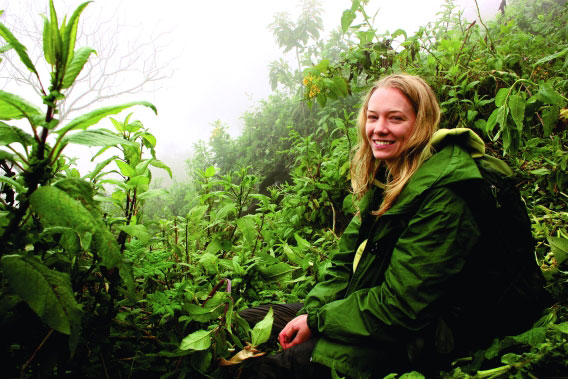Something to Chew On
Tierra Wilson’s playful invention helps safeguard endangered mountain gorillas
By Catherine O'Neill Grace
The Virunga Volcanoes region of northern Rwanda is a long way from Grass Valley, Calif., where Tierra Wilson, V10, grew up on a small farm where animals were members of the family. But her quest to preserve an endangered species led her to remote areas of Africa to work on a research project to monitor the health of free-living mountain gorillas there.

Tierra Wilson, V10, stands amid the dense vegetation that shelters a dwindling population of mountain gorillas in Rwanda. Photo: Courtesy of Tierra Wilson
In these days of ecotourism, “you can be on a plane, breathing in a bath of pathogens, and then be sitting by a gorilla a few hours later,” says Wilson. “Yet we know so little about these animals. It’s really uncharted territory, and they’re so endangered.”
Last summer, Wilson worked with the Mountain Gorilla Veterinary Project to develop a non-invasive saliva collection technique that will allow wildlife veterinarians to better monitor disease outbreaks among the endangered primates, which now number only about 700 in the world. They all live in the forests of the Virunga Mountains in central Africa, on the volcanic slopes of Rwanda, Uganda and the Democratic Republic of Congo.
While ecotourism has brought greater economic stability to the area, it has also greatly increased the risk that mountain gorillas may catch human diseases. Several gorilla troops have been habituated to humans, and there have been outbreaks of respiratory disease in the troops, including influenza, parainfluenza, respiratory syncytial virus and adenovirus.
The gorillas are also threatened by habitat encroachment. Local farmers are cultivating land up to the boundaries of the parks where the animals are protected. Poaching, war and civil unrest also have exacted a toll on the population.
Traditionally, non-invasive health monitoring of the mountain gorilla population has been done by collecting and analyzing feces. While this method minimizes the gorillas’ stress and does not disrupt their social structure, it makes early detection and diagnosis of disease outbreaks difficult, because many pathogens are not detectable in feces. Chewed plant samples, on the other hand, are easier to collect and contain secretions directly related to the respiratory tract.
To collect the gorillas’ saliva for diagnostic testing, Wilson gathered up discarded wild celery that they had munched on and found there was enough saliva to assess the presence of pathogenic bacteria and viruses.
Then Wilson came up with a playful innovation: she designed a toy designed to harvest gorilla saliva.
“We were a bit skeptical, especially because gorillas tend to destroy their toys,” according to Lucy Spelman, the regional veterinary director for the Mountain Gorilla Veterinary Project and former director of the National Zoo in Washington, D.C., writing in her blog.
“Tierra tried out two versions of the saliva chew toy. Each used thick (0.5-inch) dental rope soaked in juice. One was a plastic container with holes drilled in the lid. Tierra plugged these holes with several short bits of rope, but the gorillas promptly pulled them out. The other, a mesh bag large enough to contain a longer piece of juice-soaked rope, worked beautifully. The gorillas put the bags in their mouths and chewed on the rope, trying to extract every bit of juice. When Tierra later centrifuged the chewed-on rope, she recovered lots of alpha-amylase-positive fluid,” which indicates the presence of saliva.
Wilson’s saliva collection methods have potential to improve monitoring of the mountain gorillas’ health, as well as provide data on their stress hormones and DNA.
During her time at the Cummings School, Wilson has also conducted research on tuberculosis in elephants in Nepal. Her affinity for primates was nurtured before vet school, when she worked with the Gorilla Foundation in California as a research assistant and caregiver for Koko, a gorilla famous for learning sign language.
Working with endangered mountain gorillas was a logical extension of that passion, says Wilson. “I felt I could make the most difference working with them.”
To learn more about the Mountain Gorilla Veterinary Project, go to www.gorilladoctors.com. This story first appeared in the Winter 2008 Tufts Veterinary Medicine magazine. Catherine O’Neill Grace can be reached at catherine.grace@tufts.edu.


